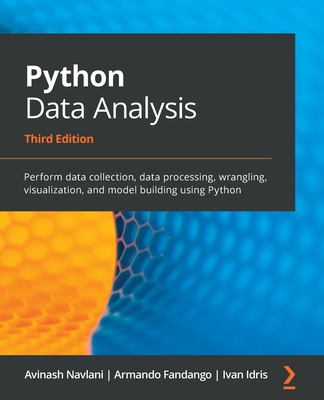Python for Finance Cookbook : Over 80 powerful recipes for effective financial data analysis, 2/e (Paperback)
暫譯: Python 財務食譜:超過 80 個強大的食譜,用於有效的金融數據分析,第二版 (平裝本)
Lewinson, Eryk
- 出版商: Packt Publishing
- 出版日期: 2022-12-30
- 售價: $1,800
- 貴賓價: 9.5 折 $1,710
- 語言: 英文
- 頁數: 740
- 裝訂: Quality Paper - also called trade paper
- ISBN: 1803243198
- ISBN-13: 9781803243191
-
相關分類:
Python
-
相關翻譯:
Python 金融數據分析 (簡中版)
立即出貨 (庫存=1)
買這商品的人也買了...
-
 Eviews 高手-財經計量應用手冊, 2/e
Eviews 高手-財經計量應用手冊, 2/e$500$475 -
 $419Excel儀表盤實戰
$419Excel儀表盤實戰 -
 $1,015MATLAB 金融風險管理師 FRM : 金融科技 Fintech 應用
$1,015MATLAB 金融風險管理師 FRM : 金融科技 Fintech 應用 -
 $428對比 Excel,輕松學習 Python 報表自動化
$428對比 Excel,輕松學習 Python 報表自動化 -
 $407跟李銳學Excel數據分析
$407跟李銳學Excel數據分析 -
 $473機器學習極簡入門
$473機器學習極簡入門 -
 $458輕鬆學 MATLAB 2021 從入門到實戰 (案例·視頻·彩色版)
$458輕鬆學 MATLAB 2021 從入門到實戰 (案例·視頻·彩色版) -
 預約未來財富:88則金融小常識打造投資精準眼光
預約未來財富:88則金融小常識打造投資精準眼光$380$296 -
 $2,385Causal Inference in Python: Applying Causal Inference in the Tech Industry (Paperback)
$2,385Causal Inference in Python: Applying Causal Inference in the Tech Industry (Paperback) -
 $862基於大數據的經濟形勢監測預測理論與方法
$862基於大數據的經濟形勢監測預測理論與方法 -
 Python 資料科學學習手冊, 2/e (Python Data Science Handbook: Essential Tools for Working with Data, 2/e)
Python 資料科學學習手冊, 2/e (Python Data Science Handbook: Essential Tools for Working with Data, 2/e)$980$774 -
 $374Stata統計分析從入門到精通
$374Stata統計分析從入門到精通 -
 Eviews 實戰與數據分析
Eviews 實戰與數據分析$708$673 -
 $539數據分析思維通識課 帶你看透數據真相
$539數據分析思維通識課 帶你看透數據真相 -
 $374巧用 DeepSeek 快速搞定數據分析
$374巧用 DeepSeek 快速搞定數據分析
相關主題
商品描述
Use modern Python libraries such as pandas, NumPy, and scikit-learn and popular machine learning and deep learning methods to solve financial modeling problems
Key Features
- Explore unique recipes for financial data processing and analysis with Python
- Apply classical and machine learning approaches to financial time series analysis
- Calculate various technical analysis indicators and backtest trading strategies
Book Description
Python is one of the most popular programming languages in the financial industry, with a huge collection of accompanying libraries. In this new edition of the Python for Finance Cookbook, you will explore classical quantitative finance approaches to data modeling, such as GARCH, CAPM, factor models, as well as modern machine learning and deep learning solutions.
You will use popular Python libraries that, in a few lines of code, provide the means to quickly process, analyze, and draw conclusions from financial data. In this new edition, more emphasis was put on exploratory data analysis to help you visualize and better understand financial data. While doing so, you will also learn how to use Streamlit to create elegant, interactive web applications to present the results of technical analyses.
Using the recipes in this book, you will become proficient in financial data analysis, be it for personal or professional projects. You will also understand which potential issues to expect with such analyses and, more importantly, how to overcome them.
What you will learn
- Preprocess, analyze, and visualize financial data
- Explore time series modeling with statistical (exponential smoothing, ARIMA) and machine learning models
- Uncover advanced time series forecasting algorithms such as Meta's Prophet
- Use Monte Carlo simulations for derivatives valuation and risk assessment
- Explore volatility modeling using univariate and multivariate GARCH models
- Investigate various approaches to asset allocation
- Learn how to approach ML-projects using an example of default prediction
- Explore modern deep learning models such as Google's TabNet, Amazon's DeepAR and NeuralProphet
Who this book is for
This book is intended for financial analysts, data analysts and scientists, and Python developers with a familiarity with financial concepts. You'll learn how to correctly use advanced approaches for analysis, avoid potential pitfalls and common mistakes, and reach correct conclusions for a broad range of finance problems.
Working knowledge of the Python programming language (particularly libraries such as pandas and NumPy) is necessary.
商品描述(中文翻譯)
使用現代的 Python 函式庫,如 pandas、NumPy 和 scikit-learn,以及流行的機器學習和深度學習方法來解決金融建模問題
主要特點
- 探索使用 Python 進行金融數據處理和分析的獨特配方
- 將經典和機器學習方法應用於金融時間序列分析
- 計算各種技術分析指標並回測交易策略
書籍描述
Python 是金融行業中最受歡迎的程式語言之一,擁有大量的附屬函式庫。在這本《Python for Finance Cookbook》的新版本中,您將探索數據建模的經典量化金融方法,如 GARCH、CAPM、因子模型,以及現代的機器學習和深度學習解決方案。
您將使用流行的 Python 函式庫,僅需幾行程式碼即可快速處理、分析和得出金融數據的結論。在這個新版本中,更加強調探索性數據分析,以幫助您可視化並更好地理解金融數據。在此過程中,您還將學習如何使用 Streamlit 創建優雅的互動式網頁應用程式,以展示技術分析的結果。
通過本書中的配方,您將熟練掌握金融數據分析,無論是用於個人還是專業項目。您還將了解在進行此類分析時可能遇到的潛在問題,更重要的是,如何克服這些問題。
您將學到的內容
- 預處理、分析和可視化金融數據
- 探索使用統計(指數平滑、ARIMA)和機器學習模型的時間序列建模
- 發掘先進的時間序列預測算法,如 Meta 的 Prophet
- 使用蒙地卡羅模擬進行衍生品估值和風險評估
- 探索使用單變量和多變量 GARCH 模型的波動性建模
- 研究各種資產配置方法
- 學習如何使用違約預測的範例來處理機器學習專案
- 探索現代深度學習模型,如 Google 的 TabNet、Amazon 的 DeepAR 和 NeuralProphet
本書適合誰
本書適合金融分析師、數據分析師和科學家,以及對金融概念有一定了解的 Python 開發者。您將學習如何正確使用先進的分析方法,避免潛在的陷阱和常見錯誤,並為廣泛的金融問題得出正確的結論。
需要具備 Python 程式語言的工作知識(特別是 pandas 和 NumPy 等函式庫)。
目錄大綱
1. Acquiring Financial Data
2. Data Preprocessing
3. Visualizing Financial Time Series
4. Exploring Financial Time Series Data
5. Technical Analysis and Building Interactive Dashboards
6. Time Series Analysis and Forecasting
7. Machine Learning-Based Approaches to Time Series Forecasting
8. Multi-Factor Models
9. Modelling Volatility with GARCH Class Models
10. Monte Carlo Simulations in Finance
11. Asset Allocation
12. Backtesting Trading Strategies
13. Applied Machine Learning: Identifying Credit Default
14. Advanced Concepts for Machine Learning Projects
15. Deep Learning in Finance
目錄大綱(中文翻譯)
1. Acquiring Financial Data
2. Data Preprocessing
3. Visualizing Financial Time Series
4. Exploring Financial Time Series Data
5. Technical Analysis and Building Interactive Dashboards
6. Time Series Analysis and Forecasting
7. Machine Learning-Based Approaches to Time Series Forecasting
8. Multi-Factor Models
9. Modelling Volatility with GARCH Class Models
10. Monte Carlo Simulations in Finance
11. Asset Allocation
12. Backtesting Trading Strategies
13. Applied Machine Learning: Identifying Credit Default
14. Advanced Concepts for Machine Learning Projects
15. Deep Learning in Finance





























